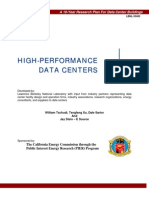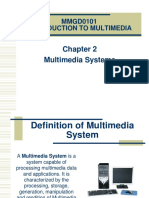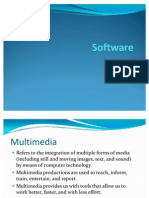Five Generation of Computer
Five Generation of Computer
Uploaded by
fayyaz aliCopyright:
Available Formats
Five Generation of Computer
Five Generation of Computer
Uploaded by
fayyaz aliOriginal Title
Copyright
Available Formats
Share this document
Did you find this document useful?
Is this content inappropriate?
Copyright:
Available Formats
Five Generation of Computer
Five Generation of Computer
Uploaded by
fayyaz aliCopyright:
Available Formats
FIVE GENERATION OF COMPUTER
First Generation (1940-1956) Vacuum Tubes
The first computers used vacuum tubes for circuitry and magnetic drums for
memory, and were often enormous, taking up entire rooms. They were very
expensive to operate and in addition to using a great deal of electricity, the first
computers generated a lot of heat, which was often the cause of malfunctions.
First generation computers relied on machine language, the lowest-level
programming language understood by computers, to perform operations, and they
could only solve one problem at a time, and it could take days or weeks to set-up a
new problem. Input was based on punched cards and paper tape, and output was
displayed on printouts.
The UNIVAC and ENIAC computers are examples of first-generation computing
devices. The UNIVAC was the first commercial computer delivered to a business
client, the U.S. Census Bureau in 1951.
A UNIVAC computer at the Census Bureau.
Image Source: United States Census Bureau
Recommended Reading: The First Computer, Webopedia's ENIAC definition. The
first computer, ENIAC, was developed by Army Ordnance to compute World War
II ballistic firing tables. It weighed 30 tons and used 200 kilowatts of electric
power.
Second Generation
Computers (1955-1964)
The second generation
computers used transistors. The
scientists at Bell laboratories
developed transistor in 1947.
These scientists include John
Barden, William Brattain and
William Shockley. The size of
the computers was decreased by
replacing vacuum tubes with
transistors. The examples of
second generation computers are
IBM 7094 series, IBM 1400 series and CDC 164 etc.
Advantages
Smaller in size as compared to the first generation computers.
The 2nd generation Computers were more reliable
Used less energy and were not heated.
Wider commercial use
Better portability as compared to the first generation computers.
Better speed and could calculate data in microseconds
Used faster peripherals like tape drives, magnetic disks, printer etc.
Used Assembly language instead of Machine language.
Accuracy improved.
Disadvantages
Cooling system was required
Constant maintenance was required
Commercial production was difficult
Only used for specific purposes
Costly and not versatile
Puch cards were used for input.
Third Generation Computers (1964-1975)
The Third generation computers used
the integrated circuits (IC). Jack Kilby
developed the concept of integrated
circuit in 1958. It was an important
invention in the computer field. The first
IC was invented and used in 1961. The
size of an IC is about ¼ square inch. A
single IC chip may contain thousands of
transistors. The computer became
smaller in size, faster, more reliable and
less expensive. The examples of third
generation computers are IBM 370, IBM System/360, UNIVAC 1108 and
UNIVAC AC 9000 etc.
Advantages
Smaller in size as compared to previous generations.
More reliable.
Used less energy
Produced less heat as compared to the previous two generations of
computers.
Better speed and could calculate data in nanoseconds.
Used fan for heat discharge to prevent damage.
Maintenance cost was low because hardware failure is reare.
Totally general purpose
Could be used for high-level languages.
Good storage
Versatile to an extent
Less expensive
Better accuracy
Commercial production increased.
Used mouse and keyboard for input.
Disadvantages
Air conditioning was required.
Highly sophisticated technology required for the manufacturing of IC chips.
Fourth Generation Computers (1975-Present)
The fourth generation computers started
with the invention of Microprocessor. The
Microprocessor contains thousands of ICs.
Ted Hoff produced the first
microprocessor in 1971 for Intel. It was
known as Intel 4004. The technology of
integrated circuits improved rapidly. The
LSI (Large Scale Integration) circuit and
VLSI (Very Large Scale Integration)
circuit was designed. It greatly reduced
the size of computer. The size of modern
Microprocessors is usually one square inch. It can contain millions of electronic
circuits. The examples of fourth generation computers are Apple Macintosh &
IBM PC.
Advantages
More powerful and reliable than previous generations.
Small in size
Fast processing power with less power consumption
Fan for heat discharging and thus to keep cold.
No air conditioning required.
Totally general purpose
Commercial production
Less need of repair.
Cheapest among all generations
All types of High level languages can be used in this type of computers
Disadvantages
The latest technology is required for manufacturing of Microprocessors.
Fifth Generation Computers
(Present & Beyond)
The Fifth Generation Computer
Systems (FGCS) was an initiative by
Japan's Ministry of International Trade and
Industry, begun in 1982, to create a
computer using massively parallel
computing/processing. It was to be the
result of a massive government/industry
research project in Japan during the 1980s.
It aimed to create an "epoch-making
computer" with supercomputer-like performance and to provide a platform for
future developments in artificial intelligence. There was also an unrelated Russian
project also named as fifth-generation computer (see Kronos (computer)).
In his "Trip report" paper,[1] Prof. Ehud Shapiro (which focused the FGCS project
on concurrent logic programming as the software foundation for the project)
captured the rationale and motivations driving this huge project:
"As part of Japan's effort to become a leader in the computer industry, the Institute
for New Generation Computer Technology has launched a revolutionary ten-year
plan for the development of large computer systems which will be applicable to
knowledge information processing systems. These Fifth Generation computers will
be built around the concepts of logic programming. In order to refute the
accusation that Japan exploits knowledge from abroad without contributing any of
its own, this project will stimulate original research and will make its results
available to the international research community."
You might also like
- Technology Lesson Plan Term 1 Week 5 of 2024Document2 pagesTechnology Lesson Plan Term 1 Week 5 of 2024Maphothego MogodiNo ratings yet
- Lesson Plan ApproximationsDocument1 pageLesson Plan ApproximationsJonathan Robinson67% (3)
- Unit Plan - Application and Implication of DataDocument6 pagesUnit Plan - Application and Implication of Dataapi-29749719350% (2)
- International Standards: - Functions of Drawing Instruments, Equipment, and MaterialsDocument16 pagesInternational Standards: - Functions of Drawing Instruments, Equipment, and MaterialsYohance BrowneNo ratings yet
- A PathfinderDocument6 pagesA PathfinderArwel CaisioNo ratings yet
- BMED 2 SBA Assignment 5& 6Document6 pagesBMED 2 SBA Assignment 5& 6shondelB 5No ratings yet
- FundamentalofcomputingunitplanDocument6 pagesFundamentalofcomputingunitplanapi-292491710100% (1)
- Home Economics ActivityDocument6 pagesHome Economics ActivityJerwin Arteche DalinaNo ratings yet
- New PE 1 MODULEDocument56 pagesNew PE 1 MODULEJake GuzmanNo ratings yet
- Template of Mathematics School Based AssessmentDocument13 pagesTemplate of Mathematics School Based AssessmentChet AckNo ratings yet
- Lesson Plan Number and ConversionsDocument10 pagesLesson Plan Number and Conversionsapi-285978629No ratings yet
- Class X Mathematics Arithmetic Progressions Presentation Module 1Document17 pagesClass X Mathematics Arithmetic Progressions Presentation Module 1Veeneet SheoranNo ratings yet
- SEA 2021 - 2023 Revised Assessment FrameworkDocument22 pagesSEA 2021 - 2023 Revised Assessment FrameworkNaseeb AliNo ratings yet
- Interpreting The Hardware Specifications of A Computer SystemDocument4 pagesInterpreting The Hardware Specifications of A Computer SystemOumotiaNo ratings yet
- 2019 g10 End of Term 2 AddmaDocument2 pages2019 g10 End of Term 2 AddmaTahpehs Phiri67% (3)
- 1st Form Social Studies Package Week 3&4Document2 pages1st Form Social Studies Package Week 3&4Juan PabloNo ratings yet
- Mathematics 1202 Overtime Worksheet: M T W T F S SDocument4 pagesMathematics 1202 Overtime Worksheet: M T W T F S SKeri-ann Millar0% (1)
- Anuscript - Signs - PDF: TH THDocument6 pagesAnuscript - Signs - PDF: TH THDaisy Guevara PerezNo ratings yet
- Ratio RiddlesDocument2 pagesRatio RiddlesGian Rafael YboaNo ratings yet
- Bel 422 Report WritingDocument13 pagesBel 422 Report WritingSafwan Izzaty100% (1)
- Simplifying Long Division Method Using Synthetic Division PaperDocument7 pagesSimplifying Long Division Method Using Synthetic Division PaperJobert DurangparangNo ratings yet
- Grade 10 Physics - Term 3Document8 pagesGrade 10 Physics - Term 3Trevor G. SamarooNo ratings yet
- 2021 Elective Mathematics Paper 2 SolutionDocument15 pages2021 Elective Mathematics Paper 2 Solutionmaviskwakye804No ratings yet
- Human and Social Biology SBADocument13 pagesHuman and Social Biology SBABibiNo ratings yet
- EDPM Assignments 2 & 3 2019-2020Document2 pagesEDPM Assignments 2 & 3 2019-2020Khuvindra Kevin Matai100% (1)
- Statistics Lesson Plan #1 CompletedDocument11 pagesStatistics Lesson Plan #1 CompletedSheilaNo ratings yet
- Teaching Practice 1 Toco Lesson PlanDocument4 pagesTeaching Practice 1 Toco Lesson Planapi-298948027No ratings yet
- Sba GuidelinesDocument2 pagesSba GuidelinesBrianna BaileyNo ratings yet
- Input & Output Devices QuestionsDocument4 pagesInput & Output Devices QuestionsFysal JanjowaNo ratings yet
- UNIT 4 Scientific Notation CSEC Multiple Choice QuestionsDocument2 pagesUNIT 4 Scientific Notation CSEC Multiple Choice QuestionsJagdeesh Gosine100% (1)
- Cape Unit 1 - Module 1 - Obj 6Document20 pagesCape Unit 1 - Module 1 - Obj 6Aggrie OsbourneNo ratings yet
- English Sba 2Document25 pagesEnglish Sba 2Rebecca Junor0% (1)
- Linear Programming Lesson PlanDocument2 pagesLinear Programming Lesson PlanKoteswaraRao PNo ratings yet
- Add Math S.B.ADocument6 pagesAdd Math S.B.AKennedy Avery Morgan Jr.100% (4)
- Linae Hendricks Maths SBADocument22 pagesLinae Hendricks Maths SBALinaeNo ratings yet
- Grade 9 IT Term 2 End of Term Test 2023 2Document4 pagesGrade 9 IT Term 2 End of Term Test 2023 2Deon LatchmanNo ratings yet
- Depreciation Lesson PlanDocument4 pagesDepreciation Lesson PlanFlyEngineerNo ratings yet
- Computer Assigment About Generation of ComputerDocument7 pagesComputer Assigment About Generation of Computerعرنان علی سیدNo ratings yet
- Dr. Thomas LeckyDocument9 pagesDr. Thomas LeckyralieghNo ratings yet
- Handout Numerical AnalysisDocument3 pagesHandout Numerical AnalysisBhavesh ChauhanNo ratings yet
- Building & Furniture Technology Research NewDocument56 pagesBuilding & Furniture Technology Research NewseguroleanNo ratings yet
- Measuring Angles Lesson PlanDocument6 pagesMeasuring Angles Lesson PlanallanNo ratings yet
- SS 1 COMPUTER STUDIES 3RD TERM Updated NoteDocument10 pagesSS 1 COMPUTER STUDIES 3RD TERM Updated NoteDAYONo ratings yet
- 1 Curriculum Guides Infants 1 PDFDocument145 pages1 Curriculum Guides Infants 1 PDFDele Awodele0% (1)
- Intergrated Science SyllabusDocument36 pagesIntergrated Science SyllabusBlessing Chisadza67% (3)
- Boyles Law & Charles LawDocument24 pagesBoyles Law & Charles LawDelano PeteNo ratings yet
- Lesson Plan Framework Mathematics Secondary Pre Calc 11Document3 pagesLesson Plan Framework Mathematics Secondary Pre Calc 11api-452943700No ratings yet
- Unit Plan On Consumer Arithmetic For Form 4Document16 pagesUnit Plan On Consumer Arithmetic For Form 4api-537308426No ratings yet
- Action PlanDocument8 pagesAction Planmuhammad adilNo ratings yet
- Some CXC Math MC Questions PDFDocument17 pagesSome CXC Math MC Questions PDFnaseeb100% (1)
- 0 - Course Outline Emp 410 (2019 - 2020)Document3 pages0 - Course Outline Emp 410 (2019 - 2020)Victor KipkoechNo ratings yet
- Activity 2019 ZAME Report City of Hope-1Document6 pagesActivity 2019 ZAME Report City of Hope-1Bricious Mulimbi75% (4)
- Dawson - Trigonometer TaskDocument9 pagesDawson - Trigonometer Taskapi-509152649No ratings yet
- YEAR 1 Practicum Observation 2023Document43 pagesYEAR 1 Practicum Observation 2023Marnalee WilsonNo ratings yet
- S.B.A. Guidelines Sections of Completed Studv: CSEC Geography Couva East Secondary SBA Guidelines Mrs. T. Persad-SmithDocument3 pagesS.B.A. Guidelines Sections of Completed Studv: CSEC Geography Couva East Secondary SBA Guidelines Mrs. T. Persad-SmithAjay Maharaj100% (3)
- Appreciation and Depreciation WorksheetDocument2 pagesAppreciation and Depreciation WorksheetDj'Dez CvfNo ratings yet
- Five Generations of ComputersDocument3 pagesFive Generations of ComputersKamran AbdullahNo ratings yet
- Generation of ComputersDocument4 pagesGeneration of ComputerskrishnamrajuvetukuriNo ratings yet
- Generation of Computers NotesDocument5 pagesGeneration of Computers Notesapi-291002394100% (1)
- First Generation of Computers (1942-1955)Document5 pagesFirst Generation of Computers (1942-1955)Sudhakar MuthusamyNo ratings yet
- Different Types of SoftwareDocument1 pageDifferent Types of Softwarefayyaz aliNo ratings yet
- Newspaper: City News New Computer ProjectDocument2 pagesNewspaper: City News New Computer Projectfayyaz aliNo ratings yet
- Uses of Information Technology in BusinessDocument10 pagesUses of Information Technology in Businessfayyaz aliNo ratings yet
- CHAPTER 2 Part-BDocument9 pagesCHAPTER 2 Part-Bfayyaz aliNo ratings yet
- 10 Short NotesDocument4 pages10 Short Notesfayyaz aliNo ratings yet
- CHAPTER 02 Part ADocument10 pagesCHAPTER 02 Part Afayyaz aliNo ratings yet
- Physicl Factors: Lecture By: Arif Agha GCCQDocument4 pagesPhysicl Factors: Lecture By: Arif Agha GCCQfayyaz aliNo ratings yet
- An Innovative Method of Teaching Structural Analysis and DesignDocument153 pagesAn Innovative Method of Teaching Structural Analysis and DesignmNo ratings yet
- How Do You Define Success and How Do You Measure Up To Your Own Definition - HR Interview Questions and AnswersDocument9 pagesHow Do You Define Success and How Do You Measure Up To Your Own Definition - HR Interview Questions and AnswersMohammad AsifNo ratings yet
- Deskjet F4580 Ref PDFDocument32 pagesDeskjet F4580 Ref PDFjimmie65No ratings yet
- Operating SystemDocument45 pagesOperating SystemSarthak PanNo ratings yet
- Introduction To CNC Machining: Department of Materials and Metallurgical Engineering IIT KanpurDocument36 pagesIntroduction To CNC Machining: Department of Materials and Metallurgical Engineering IIT KanpurvikasNo ratings yet
- Chs 4Document19 pagesChs 4shaktisinghdr7060No ratings yet
- Data Centers Roadmap FinalDocument53 pagesData Centers Roadmap FinalRich Hintz100% (11)
- UNM2000 Network Convergence Management System Operation Guide (Version B)Document69 pagesUNM2000 Network Convergence Management System Operation Guide (Version B)Flavio Rodrigo LeonelNo ratings yet
- MMGD0101 Chapter 2Document16 pagesMMGD0101 Chapter 2Sourav MondalNo ratings yet
- Module 6 Page 68-74Document7 pagesModule 6 Page 68-74Junar James Mahinay AbellarNo ratings yet
- U-WAM IFU 1908 enDocument270 pagesU-WAM IFU 1908 enОлександрNo ratings yet
- From February 9th To February 19thDocument7 pagesFrom February 9th To February 19thERICK SANTIAGO GUERRERO ROMERONo ratings yet
- G9 7-12 Careers1Document29 pagesG9 7-12 Careers1prince husainNo ratings yet
- Multimedia Hardware & SoftwareDocument25 pagesMultimedia Hardware & SoftwareGail Widener0% (1)
- Information Technologies Fundamentals: MusalasoftDocument45 pagesInformation Technologies Fundamentals: MusalasoftVera BoshovaNo ratings yet
- CdacDocument5 pagesCdacsuyNo ratings yet
- ICT Book Notes All LevelsDocument137 pagesICT Book Notes All LevelsKellyNo ratings yet
- CSS - 2nd Sem - 1st Quarter - DLLDocument26 pagesCSS - 2nd Sem - 1st Quarter - DLLLeo Loven LumacangNo ratings yet
- Kids and The Commodore 64 Revised (1984)Document306 pagesKids and The Commodore 64 Revised (1984)Delfin ButlonosyNo ratings yet
- ICS Part-1 VIP MCQsDocument1 pageICS Part-1 VIP MCQsAbdul SattarNo ratings yet
- Welcom To EE323-Microprocessor Interfacing Program: CE (Fall 2016)Document68 pagesWelcom To EE323-Microprocessor Interfacing Program: CE (Fall 2016)Imtiaz AzizNo ratings yet
- CS2 Programming 1Document17 pagesCS2 Programming 1Hadji TejucoNo ratings yet
- Supervisor List - Centre For ResearchDocument47 pagesSupervisor List - Centre For Researchc_anilNo ratings yet
- What Is Mechatronics ?Document7 pagesWhat Is Mechatronics ?Jayakrishna KandasamyNo ratings yet
- CT700 HBDocument25 pagesCT700 HBwayhawang02No ratings yet
- Als Assessment Form 1 Individual Learning Agreement: Department of EducationDocument9 pagesAls Assessment Form 1 Individual Learning Agreement: Department of EducationRitchie ModestoNo ratings yet
- The Effects of E Books Among The Computer Engineering Students of Adamson University With Their Laboratory ReportsDocument33 pagesThe Effects of E Books Among The Computer Engineering Students of Adamson University With Their Laboratory Reportsjuncos0729No ratings yet
- Block 1 PDFDocument54 pagesBlock 1 PDFmaulesh1982No ratings yet
- Nursing Informatics Chapter 2Document4 pagesNursing Informatics Chapter 2cirelnonesNo ratings yet
- Data Structures Using C++ by DR Varsha Patil: Oxford University Press © 2012Document49 pagesData Structures Using C++ by DR Varsha Patil: Oxford University Press © 2012Maria LavanyaNo ratings yet
































































































